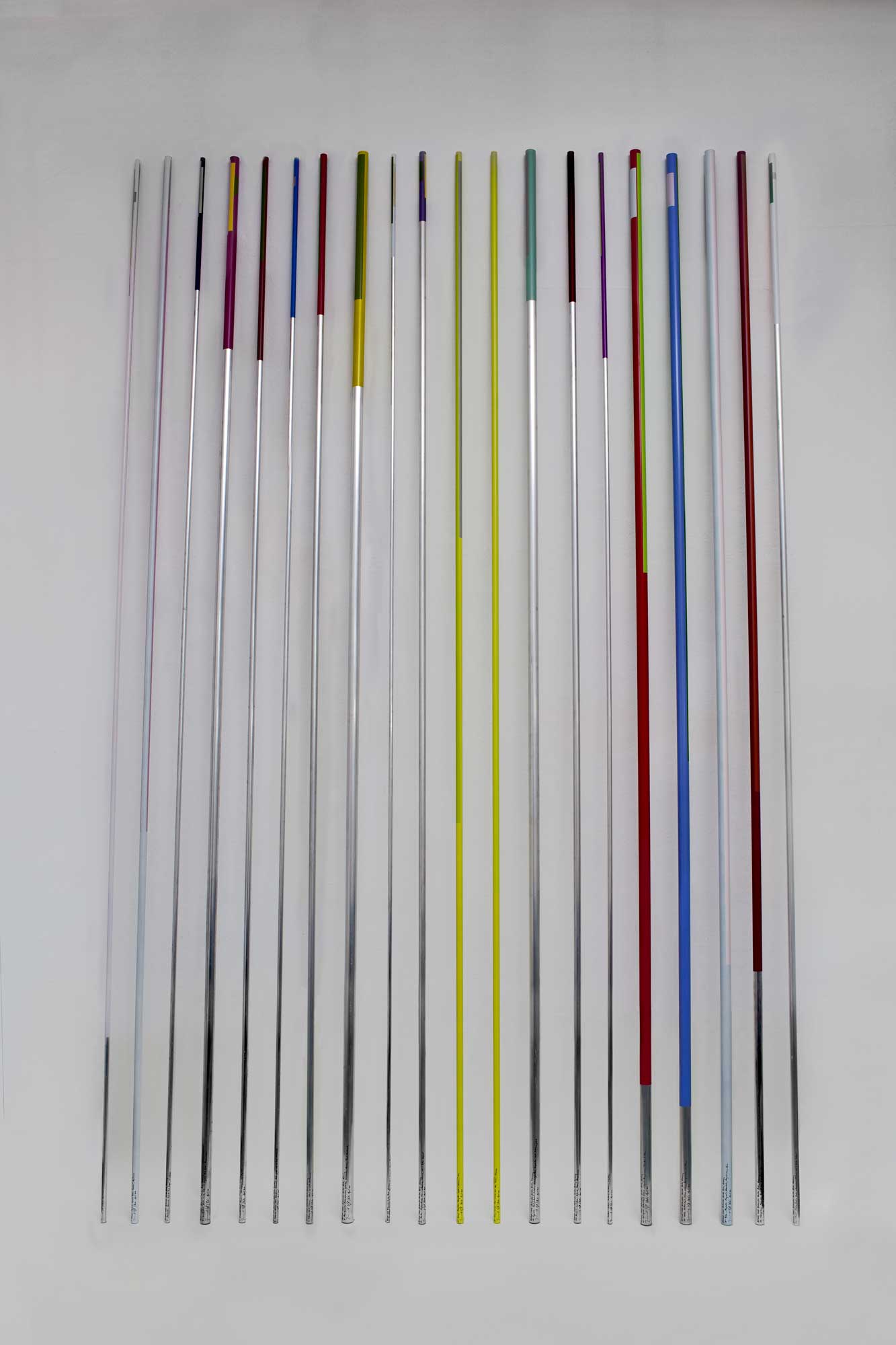
BOTANIC CODE – Botanischer Garten Berlin
Jorinde Voigt
Dahlem, Berlin 2010
(20 Stangen)
+ 1 Buch Konzept (41 Seiten)
300 cm x diverse
Aluminium, Industrielack, Tinte, Unikate
Aluminium, industrial varnish, ink, unique
1 Frühjahrskirsche, Prunus subhirtella `Autumnalis´, Rosaceae / Ø Stange: 14 mm x Länge der Stange: 300 cm WV 2010-409
2 Kobushi-Magnolie, Magnolia kobus `Loebneri´, Magnoliaceae /Ø Stange: 25 mm x Länge der Stange: 300 cm WV 2010-410
3 Blaukissen, Aubrieta-Hybride `Red Carpet´, Cruciferae / Ø Stange: 14 mm x Länge der Stange: 300 cm WV 2010-411
4 Gewöhnliche Küchenschelle, Pulsatilla Vulgaris `Rote Glocke´, Ranunculaceae / Ø Stange: 28 mm x Länge der Stange: 300 cm WV 2010-412
5 Riesensteinbrech, Bergenia `Schneekönigin´, Saxifragaceae / Ø Stange: 18 mm x Länge der Stange: 300 cm WV 2010-413
6 Labrador-Veilchen, Viola labradorica, Violaceae, Arkt.- pazif.- und zentrales Nordamerika/ Ø Stange: 14 mm x Länge der Stange: 300 cm WV 2010-414
7 Trillium sessile, Liliaceaeae, Atlant. bis mittl. Nordamerika / Ø Stange: 20 mm x Länge der Stange: 300 cm WV 2010-415
8 Amerikanischer Riesenaronstab, Lysichiton americanus, Araceae, Pazif. Nordamerika / Ø Stange: 32 mm x Länge der Stange: 300 cm WV 2010-416
9 Teufelsfarn, Osmunda claytoniana, Atlant. bis mittleres Nordamerika, Ostasien, Himalaya / Ø Stange: 12 mm x Länge der Stange: 300 cm WV 2010-417
10 Garten-Stiefmütterchen, Viola x wittrockiana, Violaceae, Nur in Kultur bekannt / Ø Stange: 20 mm x Länge der Stange: 300 cm WV 2010-418
11 Hänge-Forsythie, Forsythia suspensa, Oleaceae, China Ø Stange: 18 mm x Länge der Stange: 300 cm WV 2010-419
12 Trauer-Weide, Silber-Weide, Salix alba `Tristis´, Salicaceae / Ø Stange: 18 mm x Länge der Stange: 300 cm WV 2010-420
13 Zypressen-Heiligenkraut, Santolina chamaecyparissus, Compositae, westl. Mittelmeergebiet / Ø Stange: 30 mm x Länge der Stange: 300 cm WV 2010-421
14 Paeonia, Lactiflora-Hybride `Plena´, Paeoniaceae / Ø Stange: 20 mm x Länge der Stange: 300 cm WV 2010-422
15 Madeira-Levkoje, Matthiola maderensis, Cruciferae / Ø Stange: 14 mm x Länge der Stange: 300 cm WV 2010-423
16 Wildprets Natternkopf, Echium wildpretii, Boraginaceae, Teneriffa, La Palma / Ø Stange: 32 mm x Länge der Stange: 300 cm WV 2010-424
17 Webbs Natternkopf, Echium webbii, Boraginaceae, La Palma / Ø Stange: 32 mm x Länge der Stange: 300 cm WV 2010-425
18 Yulan-Magnolie, Magnolia denudata, Magnoliaceae, China / Ø Stange: 30 mm x Länge der Stange: 300 cm WV 2010-426
19 Kleinspitzige Alpenrose, Rhododendron mucronulatum, Ericaceae, Ostasien / Ø Stange: 25 mm x Länge der Stange: 300 cm WV 2010-427
20 Vilmoris Glockenfunkie, Hosta vilmoriniana, Liliaceae, Nur in Kultur bekannt / Ø Stange: 20 mm x Länge der Stange: 300 cm WV 2010-428
WV 2010-409 bis 428


